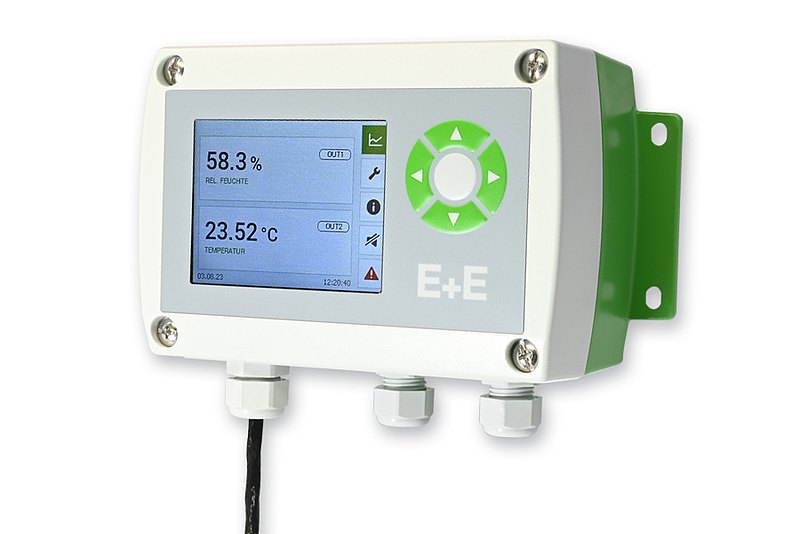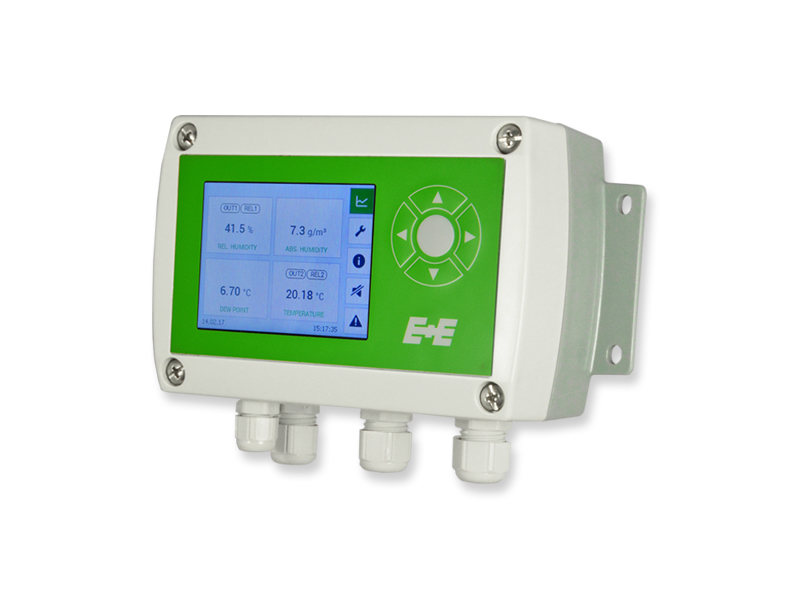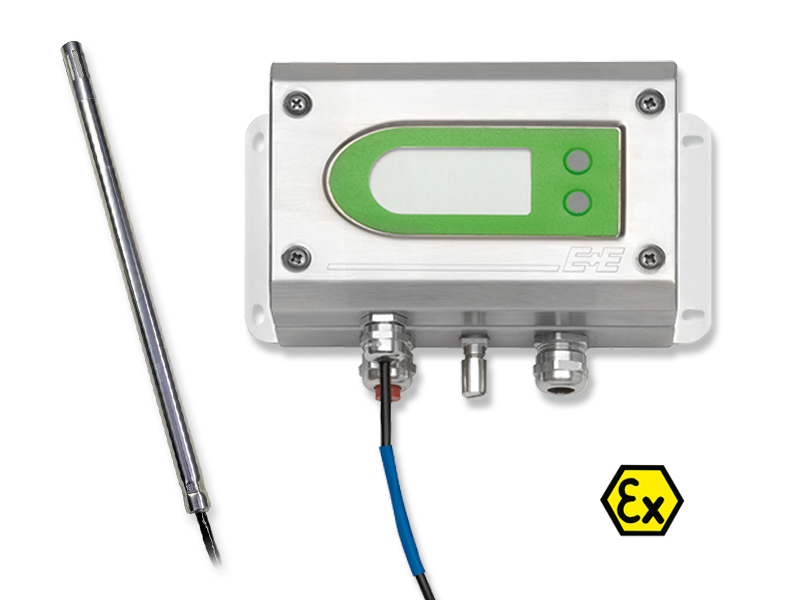Feuchte- und Temperatursensor für Anwendungen mit hoher Feuchte und chemischer Belastung

HTS801
Der HTS801 erfüllt höchste Anforderungen an eine stabile und hochgenaue Messung von relativer Feuchte (rF) und Temperatur (T) in Anwendungen mit hoher Feuchte und chemischer Belastung. Der Sensor eignet sich für einen breiten Einsatzbereich von -80 °C bis zu 180 °C und 300 bar und meistert selbst schwierigste Messbedingungen.
Der HTS801 mit T28-Fühler ist eine ideale Lösung für anspruchsvolle Messaufgaben in der Meteorologie. Das spezifische Fühlerdesign ermöglicht die einfache Integration in High-End-Strahlungsschutzschilde.
Hervorragende Messleistung
Das beheizte High-End E+E Feuchte- und Temperatursensorelement sorgt für zuverlässige und langzeitstabile Messungen in extrem feuchter oder chemisch belasteter Umgebung. Die monolithische Struktur des rF /T-Sensorelements, geschützt durch das E+E Sensor-Coating, ermöglicht eine schnelle Rückkehr zu normalen Bedingungen nach Kondensation oder chemischer Verunreinigung.
Vielseitig und robust
Die sechs HTS801-Versionen sind mit verschiedenen Fühler- und Kabellängen erhältlich. Mit verschiedenen Heizmodi kann der HTS801 perfekt auf die spezifischen Anforderungen jeder Messaufgabe zugeschnitten werden. Der Sensor verfügt über ein IP65 / NEMA 4X Polycarbonat- oder Edelstahlgehäuse, das verschiedene Schnittstellenmodule und elektrische Anschlussoptionen aufnehmen kann.
rapidX Smart Probe-Fühler
Die HTS801 bietet die Option intelligenter, steckbarer Messfühler für einen schnellen und einfachen Plug-and-Play-Fühlertausch. Jeder HTS801 rapidX Smart Probe-Fühler lädt seine spezifischen Parameter beim Verbinden mit der Geräteelektronik hoch und kann sogar im Betrieb ohne jede Konfiguration, Justage oder Kalibrierung ersetzt werden. Dies ist besonders nützlich, um Ausfallzeiten und die damit verbundenen Kosten in rauen Industrieumgebungen zu vermeiden, in denen die Sonde gelegentlich getauscht werden muss.
Ausgänge und Konfiguration
Die Messdaten stehen an zwei frei skalierbaren Analogausgängen, an der RS485- (Modbus RTU) oder Ethernet-PoE-(Modbus TCP) Schnittstelle und an den Alarm- (Relais-) Ausgängen zur Verfügung. Die Konfiguration und der rF- und T-Abgleich des HTS801 kann mit der kostenlosen Produktkonfigurationssoftware PCS10 durchgeführt werden. Für die Konfiguration und Visualisierung ist ein optionales 3,5" Farbdisplay mit Drucktasten erhältlich.
Typische Anwendungen
- Trocknungsprozesse für Ziegel, Keramik, Holz, Beton, Polyester usw.
- Lagerräume mit hoher Luftfeuchtigkeit
- Klima-, Test- und Aushärtekammern
- Meteorologische Messungen für NMIs und Eiswarnsysteme
- Brennstoffzellen- und Automobilprüfstände
- Pharmazeutische und chemische Anwendungen
- Überwachung der Luftzufuhr von Gasmotoren
- Überwachung von Biofiltern insbesondere in geruchsintensiven Produktionsanlagen
Verlängern Sie mit den E+E Service- und Kalibrierpaketen die Gewährleistung auf bis zu 5 Jahre
Mit unseren Service-Kalibrierpaketen sind Sie auf der sicheren Seite, wenn es um die Genauigkeit und Verfügbarkeit Ihrer Messgeräte geht. Wählen Sie das passende Servicepaket für Ihr E+E Produkt und profitieren Sie von einem fachgerechten Geräteservice, kalkulierbaren Kosten und einer langfristig hohen Messgenauigkeit. Hier finden Sie weitere Informationen.

Key Features
- Höchste Messgenauigkeit
- Hochwertiges monolithisches rF/T-Sensorelement
- Breiter Einsatzbereich von -80 °C bis 180 °C
- Druckdichte Fühler bis zu 300 bar
- Heizmodi für temporäre Kondensation oder permanente Hochfeuchte
- Automatic ReCovery (ARC)-Funktion zur Beseitigung chemischer Verunreinigungen
- E+E-Sensor-Coating für hervorragende Langzeitstabilität unter rauen Bedingungen
- rapidX Smart Probe-Fühler mit integrierten Sensorelementdaten
- 3,5" TFT-Farbdisplay mit Drucktasten und Datalogging-Funktion
- Zwei Analogausgänge (Strom / Spannung)
- Fehleranzeige nach NAMUR
- RS485 (Modbus RTU) oder Ethernet-PoE (Modbus TCP) Schnittstelle
- Zwei Alarm- (Relais-) Ausgänge
- IP65 / NEMA 4X Polycarbonat- oder Edelstahl-Gehäuse
- Berechnung aller feuchtebezogenen Größen
![[Translate to Deutsch:] HTS801 features](/fileadmin/data/product/HTS801/HTS801_feature.png)
Technische Daten
- Messbereich
- 0...100 % rF
-80...180 °C - Genauigkeit
- ±0,95 % rF
±0,1 °C - Druckbereich
- Bis 300 bar
- Digitale Schnittstelle
- RS485 mit Modbus RTU
Ethernet-PoE mit Modbus TCP - Ausgänge
- 0-1/5/10 V
0/4-20 mA - Versorgung
- 24 V AC/DC
Vergleichbare Produkte
Downloads HTS801
FAQ
Use the RS485 kit for retrofitting (order number HA010605), see data sheet and user manual of your specific E+E product.
The device indicates an error according to NAMUR NE43. For details, please see the user manual of your specific E+E product.
The device has one GND connection for the power supply, an analogue output GND and an interface GND, see connection diagram in the user manual. The analogue output GND and the interface GND carry only the current output resp. interface current, which results in a more stable signal compared to a mix GND connection.
Press 2x ► | 5x ◄ | 1x ▲ | 3x ◄ | 1x ▼ | 1x ► then select the "Configuration menu" and press ENTER. Scroll down to “Diagnosis”, press ENTER and scroll down to “Password protection” here you can see the previously set password.
Connect the device via the USB service interface to a PC running PCS10 Product Configuration Software and read out the communication setting.
Alternative for device with display: the display configuration menu has a section for Modbus settings (RS485, Modbus RTU) or IP settings (Ethernet, Modbus TCP) where you can see the actual setting or change it.
Connect the device via the USB service interface to a PC running PCS10 Product Configuration Software and see at the section "Log data download" for the data memory status.
Remote probe types can be retrofitted with an Ethernet interface using HA010606, see data sheet and operation manual of your specific E+E product.
The measured data logged by the device can only be downloaded via the USB service interface to a PC running the PCS10 Product Configuration Software.
High dew point means the difference between the ambient temperature and the dew point temperature is lower than 3 °C (5,4 °F), which corresponds to RH >85 %.
The appropriate product is the HTS801-M4T7. The device features a heated sensing element and probe body (dual heating system).
Due to the direct contact of the HTS801 sensor element with the measurement medium, chemical contaminants (e.g. VOCs / vapors) can penetrate the sensor polymer and cause drift effects.
Automatic ReCovery (ARC) is used to remove this chemical contamination and thus eliminate possible drift effects of the RH /T sensing element. This is accomplished by intense heating of the sensing element.
Deviations due to chemical contamination and how fast they occur depend mainly on the concentration of the chemicals, the duration of the contamination, the temperature, and the type of chemicals.
The ARC trigger interval must be determined according to the drift response time and tolerable measurement errors. As a starting point, it is recommended that ARC be triggered every 24 hours. From there, the intervals can be optimized in a range from 1 hour to once per week. Additionally using the ARC module or Modbus commands the function can be triggered at or after a certain process step.
No. For low Dew Point measurement EE355 / EE371 are the right products, which have an auto-calibration function to ensure ±2 °C Td accuracy. The HTS801 calculates the Td values down to -80 °C according to its possible temperature range and is able to scale its analogue outputs accordingly. The HTS801 Td accuracy results from its RH and T accuracy at the operating point. The E+E Humidity calculator helps to determine the Td accuracy.







